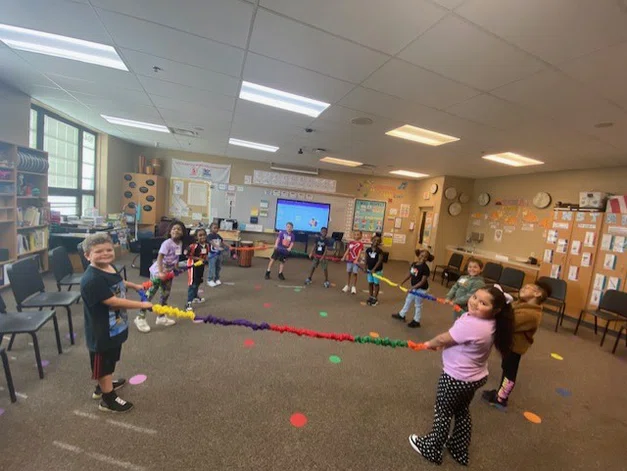©2023 Ohio Music Education Association



FEATURED ARTICLES
Building Social Well-Being in Elementary General Music
Building Social Well-Being in Elementary General Music
Lisa Gruenhagen and Anna McClure


Lisa Gruenhagen, PhD, Bowling Green State University

Anna McClure, David Hill CLC, Akron Public Schools
Well-being comprises the interdependent dimensions of physical, emotional, and social well-being. In our article featured in the spring 2024 issue of TRIAD, we discussed the profound effect music can have on all three dimensions. Here, we focus on social well-being – how building personal well-being through active engagement with music and others can result in increased social bonds and more positive attitudes for students and teachers alike.
The Importance of Teachers’ Social Well-Being
The Importance of Teachers’ Social Well-Being
Teacher wellbeing is reflected in a positive attitude toward teaching that stems from supportive relationships with colleagues and students, the belief that one has the ability to teach effectively, and the feeling that one’s personal and professional needs and expectations are met (REL Pacific, 2020).
When teachers reflect on their daily practice, it often centers on their classroom environment, student engagement, and student achievement. It is less often they center their reflections on the social, physical, and emotional well-being of their students, or their personal well-being. Arguments, unkind words, and excluding others signal teachers to focus on the well-being of their students. However, it often isn’t until times of stress, after teachers have reached their breaking point, that they reflect upon their own well-being. Each dimension of well-being is essential, but figuring out which one needs prioritizing can be difficult. Below is a series of questions to assist in discovering when it’s time to focus on your social well-being.
- Have you talked to an adult at school today?
- Have you talked to an adult at school today about things unrelated to school?
- Do you have a “teacher bestie” or someone you feel comfortable going to when you need help?
- Do professionals in the building “get along” with limited or no tension?
- Have you laughed with someone today?
- Building supportive relationships to gather solutions and help manage job stress, rather than going it alone.
- Creating partnerships or collaborating by sharing curriculum, activity ideas, and resources.
- Building relationships while volunteering to support a worthy cause with like-minded people.
- Participating in social activities like performing music together, having coffee, or going for a walk (ExtendED Notes, 2019).
The Importance of Teachers’ Social Well-Being
The Importance of Teachers’ Social Well-Being
There is almost always an opportunity to celebrate creativity and student engagement every time a student enters a general music classroom. It is important to remember that many of our students live with trauma that negatively impacts their ability to learn or behave in the classroom. They, like most of us, could use a little fun in their lives (Varner, 2023, p. 35).
The questions below can help you determine if your students need to build their social well-being:
- Are students being “left out” or picked last for group or partner activities?
- Do students complain about sitting next to a particular student?
- Have students drifted to you by themselves, instead of socializing with other students?
- Do students argue with each other during class about circumstances outside of music?
- Do students pass out materials in a random order or to the people they like first?
While you may not be able to control every situation and solve every problem, you can build social well-being for yourself and your students in your music classes. It is important that the activities you chose to do so truly foster social well-being and support students’ level of physical and emotional well-being. In conclusion, we offer some ideas below for building social well-being in your classroom.
- If students feel physically comfortable in the space, you can highlight that strength while building social well-being. You might consider the book All are Welcome, by Alexandra Penfold, with an accompanying song. An extension activity where students walk around and greet each other without using words is a quick way to enhance social connection. In our experience, students are more likely to be more inclusive when they have the freedom to choose their greeting and set a personal boundary.
- When students struggle physically in the classroom, but there is a need to build social well-being we focus on inclusive activities that limit physical movement. With younger students, we utilize a large stretchy band to build teamwork through steady beat activities, circle dances to practice walking without pulling, and rotating the band in a circle while standing still. Using a stretchy band allows students to participate at their comfort level, while not impacting the performance of those around them.
- When students have a solid foundation in emotional well-being, group or partner activities can support social well-being on a more personal level. For example, through collaboration and the exchange of ideas during improvisation, composition, and creative movement activities, students can build supportive relationships.
- If students are more self-conscious, attention to language can be beneficial in the classroom. Using neutral language helps students talk with each other while avoiding statements that can be emotionally charged. Teaching students how to use feedback statement starters such as “I notice”, “I value”, “I wonder” can foster positive peer interactions.
References
- Gruenhagen, L. M., & McClure, A. (2024). Fostering well-being in elementary general music. TRIAD, https://triad.omea-ohio.org/fostering-well-being-in-elementary-general-music
- ExtendED Notes (2019). Why social wellness is important for educators. https://www.extendednotes.com/after-school-articles/why-social-wellness-is-important-for-educators
- REL Pacific Regional Educational Laboratory (2020). How to grow teacher wellbeing in your schools. IES REL Program. https://ies.ed.gov/ncee/rel/infographics/pdf/REL_PA_How_To_Grow_Teacher_Wellbeing_in_Your_Schools.pdf
- Varner, E. (2023). SEL, mindfulness, and the art of general music education. Journal of General Music Education. Vol. 36(2), 34–37. DOI: 10.1177/27527646221130320

Lisa Gruenhagen, PhD is on the music education faculty of Bowling Green State University where she teaches undergraduate and graduate courses and is the area coordinator for general music.

Anna McClure, MM is on the faculty at David Hill CLC, Akron Public Schools, where she teaches K-5 general music along with beginning band and orchestra.




